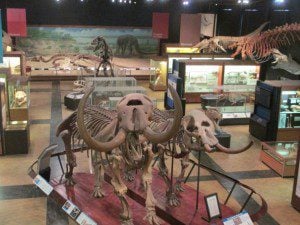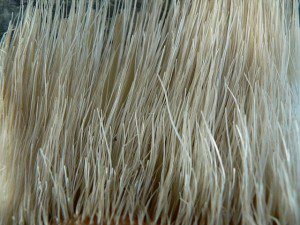 But what do the fossils say no to? (Spoiler: It isn’t evolution.)
But what do the fossils say no to? (Spoiler: It isn’t evolution.)
I’ve been summarizing and reviewing Robert Asher’s book Evolution and Belief: Confessions of a Religious Paleontologist. Dr. Asher is a specialist in mammalian evolution as evidenced in the fossil record. He is Curator of Vertebrates at the Museum of Zoology, Cambridge UK. In previous chapters he ran through the evidence for transitional species in the fossil record. The appearance of mammals and the evolution of elephants were considered in detail. We all find the mammoth and mastodon impressive.
Today we will look at the evolution of whales and then consider Asher’s summary of the evidence for transitional species in the fossil record. Creationist claims that these are absent or sparse are inaccurate.
 The evolution of whales. A powerful example of evolution is found in the evidence for the gradual appearance whales some 50 million years ago … from land mammals related to modern even-toed ungulates to fully aquatic “fish”. In fact, whales are one of the most commonly cited examples where a string of intermediate forms have been identified (image is a Basilosaurus fossil). Many of these fossils retain clear evidence of hind limbs gradually disappearing through the generations. If you click on the image above you can see the hind limbs in the lower right corner. These are rudimentary, perhaps of use in reproduction, but certainly not for locomotion.
The evolution of whales. A powerful example of evolution is found in the evidence for the gradual appearance whales some 50 million years ago … from land mammals related to modern even-toed ungulates to fully aquatic “fish”. In fact, whales are one of the most commonly cited examples where a string of intermediate forms have been identified (image is a Basilosaurus fossil). Many of these fossils retain clear evidence of hind limbs gradually disappearing through the generations. If you click on the image above you can see the hind limbs in the lower right corner. These are rudimentary, perhaps of use in reproduction, but certainly not for locomotion.
 A less commonly cited element of whale evolution is the divergence of toothed and baleen whales. The oldest whales were toothed like their land dwelling ancestors. The Basilosaurus above had some pretty impressive teeth. The baleen whales (filter feeders like the blue whale and the humpback) diverged from this line, likely beginning some forty million years ago or so. Paleontologists have identified a series of fossils exhibiting the development of the baleen and the loss of teeth as well as the gradual development of other features observed in baleen whales.
A less commonly cited element of whale evolution is the divergence of toothed and baleen whales. The oldest whales were toothed like their land dwelling ancestors. The Basilosaurus above had some pretty impressive teeth. The baleen whales (filter feeders like the blue whale and the humpback) diverged from this line, likely beginning some forty million years ago or so. Paleontologists have identified a series of fossils exhibiting the development of the baleen and the loss of teeth as well as the gradual development of other features observed in baleen whales.
The features characteristic of today’s baleen whales did not appear fully formed all at once. Many fossil species exhibit a mixture of features. Some early ancestors had both teeth and what appears to be the beginning of baleen. Aetiocetus provides one such example, although the evidence for baleen is indirect rather than direct (baleen, being a “keratinous substance similar to your fingernails” doesn’t fossilize readily like teeth and bones, image: source). Dr. Asher notes that the presence of a baleen in Aetiocetus is still a subject of investigation and discussion. However, there is substantial evidence that whales with a combination of baleen and teeth existed for some ten million years alongside both toothed and baleen whales before going extinct.
Modern genetics shines more light in this issue. No living adult baleen whale has both functional teeth and baleen. However, baleen whales do have genes and pseudo-genes for teeth. Asher points out that “modern baleen whales begin the process of tooth formation prior to birth. “Teeth” in a minke whale never fully form or break the gums, but they do at least begin to develop and their rudiments can be seen in fetal specimens.” (p. 137) Figure 7.4 in the book illustrates the presence of rudimentary teeth in a fetus. Three major genes important for the formation of enameled teeth were included by Deméré and colleagues in a broad study of baleen whale evolution (Systematic Biology, 57: 15-37, 2008).
DMP I (dentin matrix acidic phosphoprotein), AMBN (ameloblastin) and ENAM (enamelin). DMP I is known to contribute to the development of not only dentine but also other tissues such as bone and cartilage. The AMBN and ENAM proteins appear to express most strongly in the process of enamel formation in developing teeth. (P. 137)
…
They found that all three genes (DMP I, AMBN, ENAM) are present in baleen whales, but the two enamel-specific ones, AMBN and ENAM, have lost their enamel-producing function. Unlike the sequences in toothed whales (dolphin), even-toed ungulates (hippo, cow, pig, camel), and other mammals (human, mouse, rat, dog), their samples of these genes in modern baleen whales exhibited what are called frameshift mutations. That is, the basic sequences of AMBN and ENAM are present, but are missing critical elements that keep them from finishing what they do in other mammals, namely, synthesize proteins relevant to the formation of tooth enamel. Interestingly, such mutations were not present in the third protein [probably a typo – should be gene], DMP I, which is demonstrably involved in processes besides tooth formation, such as bone and cartilage development. (p. 138)
Asher argues that these genetic remnants are hard to rationalize in any special creation model, especially a young earth model, but are entirely consistent with evolution by natural selection. This is what evolutionary theory predicts if a baleen whale evolved from toothed ancestors. Once upon a time these genes served an important function still served in other mammals, but they are unnecessary in the baleen whales. The remnants remain because they have no negative influence for the current generation. They accumulate errors because in the first instance the absence of function may be an advantage and once the gene is turned off there is no selective pressure to preserve the gene sequence.
We know that the fetuses of modern baleen whales have the capacity to initiate the development of both teeth and baleen (Figure 7.4). The AMBN and ENAM genes present in baleen whales provide an example of what are known as genetic fossils, discoveries of which are becoming increasingly common elsewhere in the biological world. Again, such genetic fossils are not simply cases of suboptimal design. They demonstrate not only that animals retain genetic remnants of structures that are now of little or no use to them; they also represent signposts indicative of the specific part of the Tree of Life from which the animal involved evolved. Baleen whales descended from other animals with teeth, and their enamel pseudogenes (among other lines of evidence) prove it. (p. 138-139)
Transitional species are abundant in the fossil record. In many instances these transitions are corroborated by “genetic fossils” present in the genomes of modern species and by developmental stages in the embryo and fetus.
The Problem with Creationism. In the next chapter, Creationism: The Fossils Still Say No!, Asher digs deeper into some of the issues confronting anti-evolutionary creationism. First, the examples he has discussed in the preceding chapters (mammals, elephants, and whales) represent the tip of the iceberg. Examples of mixed anatomical features (i.e. transitional species) abound in the fossil record. In a table on pp. 144-149 he summarizes some of the more conspicuous examples. One hundred and forty eight examples … over one hundred of them from papers published between 2000 and 2010. The supporting evidence is growing rapidly. The number could be much larger today, some five or six years after Evolution and Belief was completed. As Asher says …
This list is by no means complete, but it’s a good starting point for anyone who wants to consider creationist claims that “transitional sequences are rare, at best” or that “in the overwhelming majority of cases, Common Descent does not match the evidence of the fossil record.” In contrast to these absurd statements from Explore Evolution, the reality is that the fossil record really does match the predictions of exolution by natural selection and goes far beyond the early synapsids, elephants, and whales that I’ve summarized in this book. (p. 143)
Explore Evolution: The Arguments for and Against Neo-Darwinism is a text by Stephen C. Meyer and colleagues. Asher uses this as an unfortunate example of anti-evolution books. He finds it particularly egregious because it misrepresents work by several of his friends and colleagues (and in the process gives Christianity a bad name). He quotes a passage from the book and then continues:
All of these individuals have spent their professional lives documenting something that this passage claims does not exist: an abundance of extinct animals that exhibit a mosaic of anatomical features found in different living groups, including early amniotes, basal synapsids, dinosaurs and birds, and early cousins of placental mammals. All of these scientists disagree emphatically with the creationist overtones of Explore Evolution, yet somehow their names appear spliced alongside phrases like “critics argue that Darwin’s theory has failed an important test.” (p. 142)
This kind of misrepresentation is directly responsible for much of the bad rap that Christians get in scientific circles, especially among biologists and paleontologists. The consequences are significant. Misrepresentation may soothe the already convinced, but it pushes away the scientists and many others as well. “Even reasonable arguments made by ID advocates on certain, specific philosophical issues involving the origin of life or a possible agency behind the cosmos (see below) are received with hostility because most evolutionary biologists associate them with the blatant misquotation summarized above (and in Chapter 9).” (p. 151) Any hint of creationism can spark an outpouring of anger and strong language. A recent knee-jerk reaction to a probable translation error in a paper by several Chinese authors provides a case in point.
Asher has hard words as well for the scientists, atheistic evolutionists, who make the connection to philosophical naturalism, as though Darwinian evolution proves the non-existence of God. These people “fuel the membership rolls of various anti-Darwin movements that perpetually feed off of this misunderstanding of how evolution relates to, and is limited by, human scientific inquiry.” Richard Dawkins leads the parade, although he is far from the only culprit. Asher points out that the discussion confuses agency and cause or mechanism. Both statements: “I don’t believe in evolution because God did it” and “I don’t believe in God because evolution did it” make the same naïve error. Science cannot really say anything about the existence of God or about any agency behind creation. It can tell us about “natural” processes including those in the past. Asher notes that the inability of science to address the question of God is “more indicative of the limits of science than the lack of a deity.” (p. 153) He concludes: “Evolutionary biology is not about the origin of life or the existence of God. It is about how living things are interconnected through a specific natural mechanism, one which we can understand through the fossil record, individual development, and molecular biology.” (p. 153)
Misrepresentation, misquoting, misunderstanding, assuming the worst, … one might think we all were fallen!
Seriously though, this is a real problem in our secular society as it drives a wedge between Christians and non-Christians, making reasonable discussion difficult.
What kind of evidence for evolution is convincing?
Is it important to quote sources accurately, including intent not merely words?
Asher’s last summary of evolution … “it is about how living things are interconnected through a specific natural mechanism” … makes an important point. Evolutionary theory isn’t about taking God out of the picture. It is a comprehensive theory that explains a wide range of observations concerning interconnections.
Does this match your understanding of the nature of evolutionary biology?
If you wish to contact me directly you may do so at rjs4mail[at]att.net.
If interested you can subscribe to a full text feed of my posts at Musings on Science and Theology.















